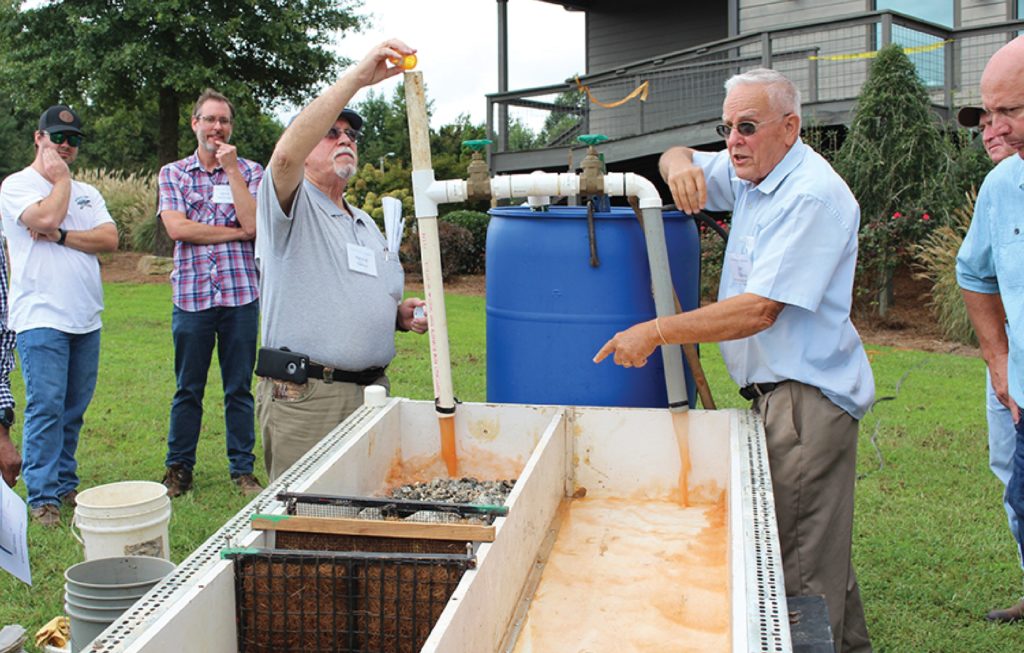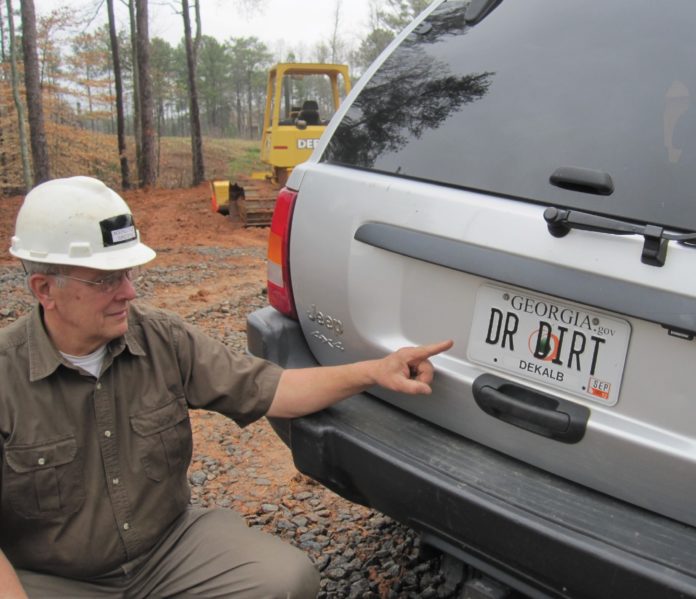Jim Spotts Devotes Career to Learning and Teaching All Things Soil
As a young boy with a lot of time on his hands, Jim Spotts learned a lot about soils in the wooded area near his home.
“I grew up in Jacksonville, Florida, and one day my friends and I decided to see how deep we needed to dig a hole to reach water,” said Spotts. “We dug the hole 6-feet deep in sand, and I volunteered to jump in to touch the water.” With wet sand caving in around his feet, he and his friends realized he was stuck, and Spotts’ father was summoned for help. “My father grabbed my hair and pulled me out of the hole, then told me that whenever I dig a hole, dig a big hole!”
Little did Spotts’ family know that years later, his vehicle license plate would read: “Dr. Dirt.”
His interest in soils, woods and the environment continued as he attended North Carolina State University, majoring in forest management. One course on soils led to his lifetime interest and career. After graduation, he joined the U.S. Forest Service, which needed a soil scientist to map the characteristics of Arkansas soils. Following military service, he returned to his work in Arkansas to earn a master’s degree from the University of Arkansas, and then a Ph.D. in soil physics from Texas A&M University.

His career in federal service is impressive:
- For the U.S. Forestry Service as soil scientist, he mapped and interpreted Arkansas soils for multiple uses.
- At the U.S. Army Corps of Engineers’ Waterways Experience Station in Vicksburg, he led a program to collect samples of dredged material extracted from river channels. In a field study, he demonstrated the effectiveness of vegetation versus engineering methods to dewater impounded dredged material.
- As the regional soil scientist in the U.S. Department of the Interior’s Office of Surface Mining Reclamation and Enforcement (OSMRE) in Kansas City, Missouri, he chaired a national committee to develop a regulatory program for sediment pond design, promoted solutions for acidic sediment found in streams below mining operations and created the first field training programs for state inspectors. Later, as the technology transfer officer at the OSMRE Regional Office in Pittsburgh, Pennsylvania, he expanded the field training program.
“I also spent three years in Peru as a private consultant for USAID, teaching soil conservation and helping local farmers grow crops on steep mountain slopes that are prone to erosion and slides,” said Spotts.
He retired in 1998 and moved to Atlanta where he developed erosion and sediment control plans for two consulting companies. In 2000, he opened his own firm, Southeast Environmental Consultants, where he continues to promote cost-effective construction-site erosion and sediment control practices. “For several years, I served as a regulatory inspector but found more pleasure in helping contractors stay out of trouble,” said Spotts.
“I’ve known and worked with Jim for 15 years and he always has the goal to help those around him when they ask for it, whether they be SWPPP designers, regulators or general contractors,” said T. Luke Owen, PG, owner and principal trainer, NPDES Stormwater Training Institute. “Jim knows that field personnel must understand the practical side of properly installing BMPs in the field to make the SWPPP truly effective. He does this by building flow diagrams and even miniature models of BMPs.”
Spotts has been a trainer at the NPDES Stormwater Training Institute for 20 years. “He goes above and beyond to make his training efforts effective,” said Owen. “He arrives early to set up his training venue, talks with students to determine their background and experience, and then stays late to talk to students about the course material after the class. Many of the models and teaching tools Spotts uses in his classes are built by him in his home office.”
The self-described “man-cave” at Spotts’ home has a full range of woodworking and metalworking tools and equipment. His commitment to teaching led Spotts to build a portable sediment pond that he transports on a trailer. The 3-ft. by 6-ft. box is split down the middle so Spotts can install a BMP on one side to show how it works in comparison to the side with no BMP when water washes through the pond.
His experience and years of studying and learning about soils is only one reason his clients and students appreciate Spotts. “The first thing you notice is his passion,” said Kim Metcalf, owner, Riverbend Environmental Inc. “Everyone in this field knows him or of him. He’s creative — his techniques for working with flocculants are unparalleled — and he’s fun.” She added, “He has an infectious, positive attitude. Even in tense meetings he has a way to get everyone united to attack the problem.”

Alabama Soil and Water Conservation Committee’s Earl Norton, CPESC, CPAg, first met Spotts at an IECA Annual Conference in the late 1990s and they have been colleagues ever since. “He is passionate about erosion and sediment control and most willing to share technology,” he said. “He has participated several times in our Alabama Clear Water AL Field Day as a trainer at sites demonstrating flocculant technology to minimize turbidity from construction stormwater. His presentations were always highly educational and participants always wanted more time with him.”
“I believe his most significant accomplishment is the acceptance and credibility he has given our industry,” said Metcalf. “Often we are seen at the job site as people that slow down the job or cost the project money. Dr. Spotts had shown how compliance is a competitive advantage and the company that properly manages erosion and sediment control issues is the leader.”
Erosion and sediment control is not just a job, it is a passion for Spotts. “I like to test new technologies in the field to see how they work, and vendors are happy to give me a chance to install and evaluate their products,” said Spotts. Often this testing is done on his own time at construction sites of clients. There are also times he sees a potential new use for a product. Not long ago, Owen and Spotts were using anionic polyacrylamide (PAM) to stabilize two massive forebays on a construction site. When Spotts applied the PAM over jute matting on the spillway, sediment in the inflow was retained on the netting and the result was clear water in body of the pond.
“My role is to help contractors realize the importance of BMPs to the success of their project,” said Spotts. He provides options and routinely inspects BMPs to enable contractors to make adjustments before inspectors arrive on site. “The worst thing that can happen on a construction site is a stop-work order,” he said. “I can help avoid those orders and the lost money they represent, so my clients are very open to my suggestions.”
Dr. Dirt also serves as a “pass through” of information that he gains from colleagues, especially those in IECA, said Spotts. “I am not the whole wheel, only one spoke.”
While he receives many compliments and accolades, there is one complaint the 83-year-old Spotts often hears. “People say I walk too fast,” he said. “I walk fast because I have a lot of ground to cover. I need 25 hours in my days.”












